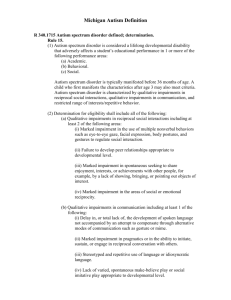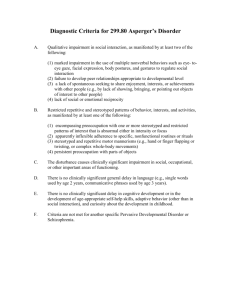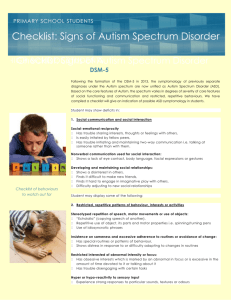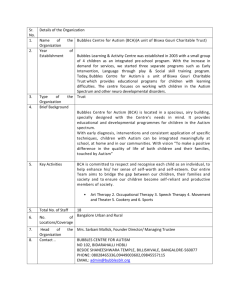What is Autism? - Cloudfront.net
advertisement
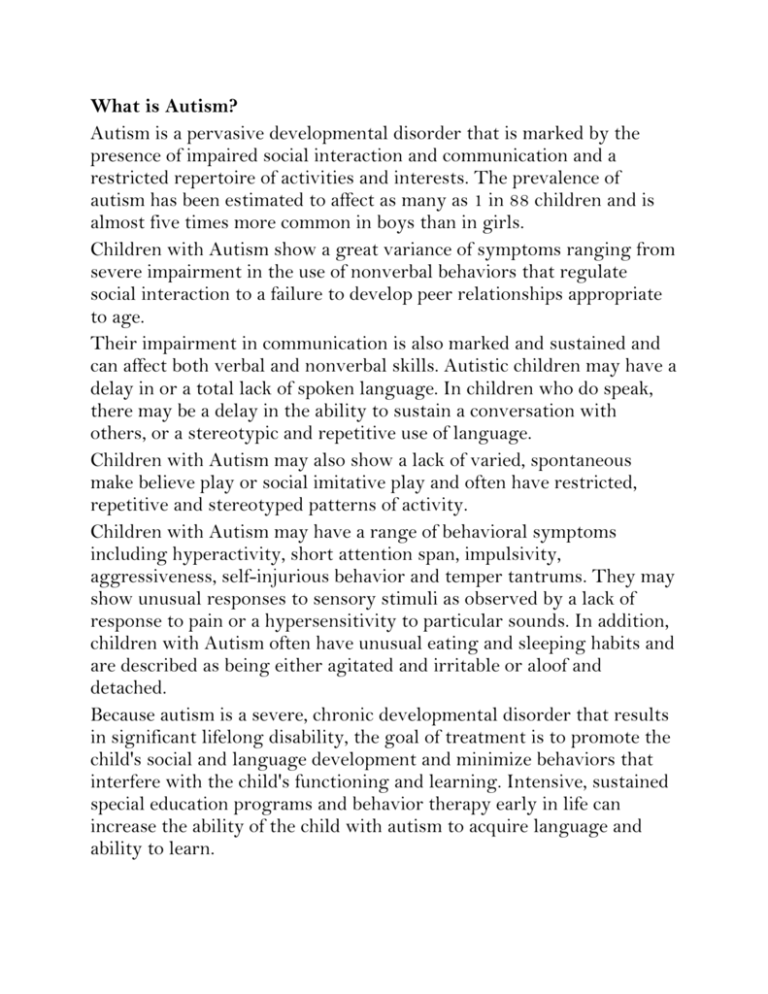
What is Autism? Autism is a pervasive developmental disorder that is marked by the presence of impaired social interaction and communication and a restricted repertoire of activities and interests. The prevalence of autism has been estimated to affect as many as 1 in 88 children and is almost five times more common in boys than in girls. Children with Autism show a great variance of symptoms ranging from severe impairment in the use of nonverbal behaviors that regulate social interaction to a failure to develop peer relationships appropriate to age. Their impairment in communication is also marked and sustained and can affect both verbal and nonverbal skills. Autistic children may have a delay in or a total lack of spoken language. In children who do speak, there may be a delay in the ability to sustain a conversation with others, or a stereotypic and repetitive use of language. Children with Autism may also show a lack of varied, spontaneous make believe play or social imitative play and often have restricted, repetitive and stereotyped patterns of activity. Children with Autism may have a range of behavioral symptoms including hyperactivity, short attention span, impulsivity, aggressiveness, self-injurious behavior and temper tantrums. They may show unusual responses to sensory stimuli as observed by a lack of response to pain or a hypersensitivity to particular sounds. In addition, children with Autism often have unusual eating and sleeping habits and are described as being either agitated and irritable or aloof and detached. Because autism is a severe, chronic developmental disorder that results in significant lifelong disability, the goal of treatment is to promote the child's social and language development and minimize behaviors that interfere with the child's functioning and learning. Intensive, sustained special education programs and behavior therapy early in life can increase the ability of the child with autism to acquire language and ability to learn. Special education programs in highly structured environments appear to help the child acquire self-care, social, and job skills. Only in the past decade have studies shown positive outcomes for very young children with autism. Given the severity of the impairment, high intensity of service needs, and costs (both human and financial), there has been an ongoing search for effective treatment. Diagnosis The diagnosis of autism is a complex and often controversial issue. The most accepted standards for diagnosis come from the Diagnostic and Statistical Manual of Mental Disorders – Fourth Edition (DSM – IV), published by the American Psychiatric Association. The MADSEC report provides a useful, succinct description of the diagnosis and relevant factors comprising it. Autism is included under DSM-IV’s pervasive developmental disorders. This is a category of disorders in which many basic areas of infant and child psychological development are affected at the same time, and to a severe degree. Autistic disorder has three major hallmarks: qualitative impairment in social interaction, qualitative impairment in communication, and restricted, repetitive and stereotypical patterns of behavior, interests, and activities. Onset in delays is very early, prior to three years of age. To meet DSM-IV diagnostic criteria for autism, children will display impairment in social interaction in at least two ways, impairment in communication in at least one way, and restricted, repetitive and stereotypical patterns of behavior, interests and activities in at least one way. According to DSM-IV, impairment in social interaction is manifested in at least two of the following ways: marked impairment in the use of multiple nonverbal behaviors such as eye-to-eye gaze, facial expression, body postures, and gestures to regulate social interaction; failure to develop peer relationships appropriate to developmental level; a lack of spontaneous seeking to share enjoyment, interests or achievement with other people; lack of social or emotional reciprocity. Impairment in communication is manifested by at least one of the following: delay in, or total lack of, the development of spoken language, not accompanied by an attempt to compensate through alternative modes of communication; in individuals with adequate speech, marked impairment in the ability to initiate or sustain conversation with others; stereotyped and repetitive use of language or idiosyncratic language, and lack of varied, spontaneous make-believe play or social imitative play appropriate to developmental level. Restricted, repetitive and stereotyped patterns of behavior, interests and activities are manifested by at least one of the following: encompassing preoccupation with one or more stereotyped and restricted patterns of interest that is abnormal either in intensity of focus; apparently inflexible adherence to specific, non-functional routines or rituals; stereotyped and repetitive motor mannerisms, such as hand or finger flapping, or complex whole body movements; While the diagnostic criteria described above are widely applicable, it is important to note that every child with autism is unique, and there is no such thing as a “average” child with autism. Each child manifests unique strengths and skill deficits and it is important to keep in mind that treatment must therefore be oriented to an assessment of the unique needs of each individual person, not simply prescribed based on a diagnosis. References: Maine Administrators of Services for Children with Disabilities (MADSEC) (2000). Report of the MADSEC Autism Task Force.
